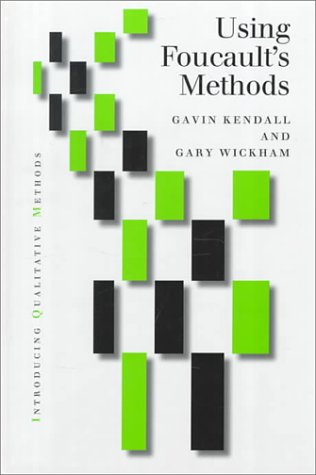Using Foucault's Methods pdf download
Par sexton samuel le samedi, juillet 15 2017, 05:14 - Lien permanent
Using Foucault's Methods by Gary Wickham, Gavin Kendall


Using Foucault's Methods Gary Wickham, Gavin Kendall ebook
Publisher:
ISBN: 0761957170, 9780761957171
Page: 171
Format: pdf
Kendall dan Wickham menjelaskan genealogy sebagai 'a new concern with the analysis of power' (1999:29). What happens to the concept of transparency if you look at it using Foucault's methods? Speed of Light Demonstration by the Foucault Method - Kevin McFarland. Drawing on recently published Collège de France lectures, it is useful to those concerned with Foucault's engagement with the 'psy-disciplines' and those interested in the practical application of Foucault's critical research methods. Using Narrative in Social Research by Jane Elliott; Using Foucault's Methods by Gavin Kendall & Gary Wickham; A 2011 title, Sage Quantitative Research Methods by W. This paper is a Foucauldian account of power relations as expressed through discourse in the on-line encyclopedia Wikipedia. In both of these works, Foucault never discusses using certain methods of speaking or stylistic choices (like vivid language) to take up more “space” in the audience's mind. Using Foucault's Methods by Gary Wickham, Gavin Kendall. Foucault worked in a variety of scientific fields, with his greatest claim to fame being a simple mechanical method for proving the rotation of the Earth—what came to be known as Foucault's Pendulum. Using Foucault's Methods Gary Wickham, Gavin Kendall Language: English Page: 171. University of Rochester A diagram showing a modern approach to measuring the speed of light using Foucault's rotating mirror method. Download Using Foucault's Methods. I was thinking almost exactly that, as I was trying to grasp the slippery fish of understanding this morning. There's lots of ways to illustrate the central dynamic – just organizational communication can unpack it in different ways – but using Foucault is a pretty short way to get to the end. [v] If Foucault intended his work for users rather than readers, an evaluation of his methods allows us to determine the degree to which we might want to use his scholarly tools. Increasing transparency seems to go hand in hand with the information age, but how far should it go? The mainstay of the book is not concerned with this narrow area, however, but its pre-history, in the sense of the academic discourses which preceded its very existence.